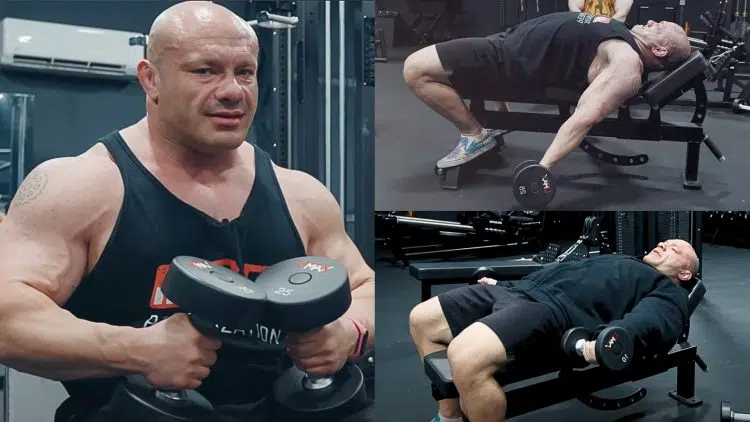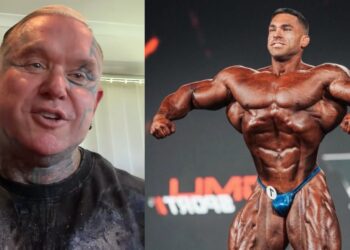If you aren’t genetically gifted with biceps that rival bodybuilding star Nick Walker’s, don’t worry, exercise scientist Dr. Mike Israetel has a new movement to boost your gains. Taking to YouTube, Dr. Israetel broke down the setup and execution of his lying dumbbell curl variation for bulletproof biceps.
For some, biceps can be notoriously challenging to grow; they are a stubborn muscle that requires a deep stretch to achieve hypertrophy. Dr. Israetel has long been after a biceps exercise that meets all of his criteria for spurring muscle growth and believes he has found the answer.
His hack for growing the biceps involves a variation of the lying dumbbell curl, though he modifies the movement’s range of motion to capitalize on each repetition. He credits this exercise for causing multiple-day delayed onset soreness, which many consider a tell-tale sign of whether or not a body part was trained effectively to stimulate muscle growth.
Try Exercise Scientist Dr. Mike Israetel’s Lying Dumbbell Curl Hack for Bigger Biceps
Even for the most stubborn-to-grow biceps, Israetel contends that this movement can produce results.
Level Up Your Fitness: Join our 💪 strong community in Fitness Volt Newsletter. Get daily inspiration, expert-backed workouts, nutrition tips, the latest in strength sports, and the support you need to reach your goals. Subscribe for free!
“If you don’t have unbelievable biceps genetics, we’re on to some shit. One exercise that I started doing recently that I invented,” shares Dr. Mike Israetel. “This exercise looks a little goofy but it fucking works and it’s the only bicep exercise ever to give me repeat back-to-back-to-back session multiple-day delayed onset muscle soreness. We’re going to teach you guys how to do lying dumbbell biceps curl.”
“Bulletproof biceps, Jared said it first, but don’t you fucking steal that, let’s get on to the exercise.”
Israetel explains that you can touch the ground with the dumbbells at the bottom of each rep, but he emphasizes keeping the tempo slow and controlled.
“You can even touch the dumbbells to the ground and you’re just going to curl up normally and you’ll notice, perfect, and then down slow, under control. You have to do the descent slow in order to control because you’ll notice your shoulder is in a bit of an interesting position.
This is a position that will make your shoulder stronger. Initially, it’s going to feel fucking a little bit weird. If it hurts your shoulder, you don’t have to go down super low. There is another variation of this.”
As Dr. Israetel has mentioned in the past, a deep stretch plays a pivotal role in muscle growth, as does the range of motion.
“The actual physical stretch when you’re all the way down here when your biceps are super popping showed really awesome hypertrophy but as long as the muscle was in a lengthened state, even if it wasn’t stretched to the maximum, and the force vectors were maximized in that lengthened state, you actually had a very similar degree of hypertrophy occurring.”
If his lying dumbbell biceps curl variation unevenly taxes the shoulders, he advises lifters to keep the elbows parallel with the bench beside their ribs, adding ‘You don’t have to go low.’
“Stretch super deep, stay at the bottom for a little bit, come up. You’ll notice there’s way more tension at the bottom and at the top, it’s much easier which is exactly how you want to train. That’s totally fine. But you may be in a position where you’re like ‘I don’t know, my shoulders feel weird going super low.’ You don’t have to go low. You can take your elbows and drive them up to parallel with the bench right by your ribs and curl like this, holding, and then up.”
“The bicep is in a lengthened position and then when it shortens, the force is way way way tinier arguably zero here because gravity doesn’t pull that way. So, you can do these like this [upwards] or you can do them with a super deep stretch [downward toward the floor].
Regardless of how you choose to perform this exercise, Israetel believes it will result in a deep stretch because the biceps are in a lengthened position.
“Either way, it’s really really good stuff. Ideally, if you wanted the deep stretch you would do them decline where you’re up with your hips and you get that maxed force vector and that stretch at the same time.”
He specified that the most challenging part of the movement is when the forearms are parallel to the ground.
“This is very hypothetical, at least perceptively gives a one-two punch. At the very bottom, it’s a psychotic stretch, not a ton of active tension but as you come up through the movement, you’re still very much at a lengthened position because of the bicep pre-stretch and you hit the hardest part of the movement when the forearms are roughly parallel with the ground,” shares exercise scientist Dr. Mike Israetel.
Sporting bigger biceps remains a top priority for many athletes, including bodybuilding legend Arnold Schwarzenegger. He advocates for preacher curls when trying to optimally grow the biceps, also emphasizing a deep stretch.
“Increasing the size of your muscles is a matter of progressive overload, training through a full range of motion — a complete stretch and a flex — and loading the muscle where it is most challenged and has leverage. It’s the last one that most people often overlook when selecting exercises.”
Former Mr. Olympia Jay Cutler has also tackled biceps training, offering insight into how long you should rest after working the body part. He takes 5-7 days off but recommends most people wait 72 hours before another biceps training session.
“What is the adequate time to rest a body part? Specifically biceps. So if I was going to train my biceps I would give myself five to seven days rest in between. Research shows that you need 72 hours to when you train a muscle with volume, to recover that muscle group.”
Helping shape other IFBB Pros, Dr. Mike Israetel’s understanding of science and exercise gives credence to his latest bicep hack. Try out his modified lying bicep curl and let us know if it helped you grow some bigger guns.
RELATED: Exercise Scientist Explains How To Build Muscle In a Calorie Deficit









